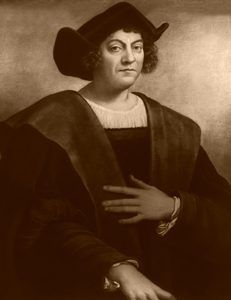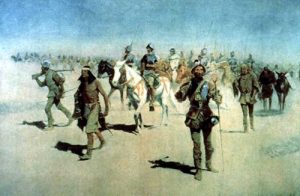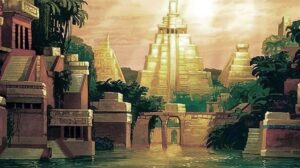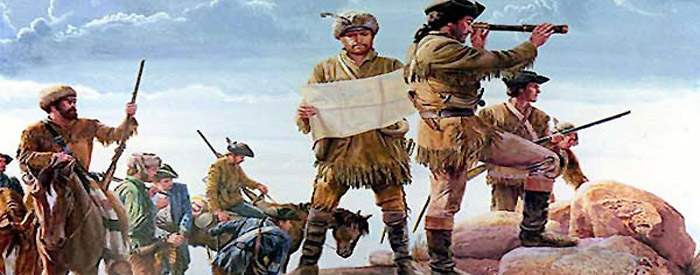
Kansas Explorations.
More than four centuries have passed since Christopher Columbus discovered America. During that time, the hunting grounds of 300,000 Indians became the United States, which has more than 100,000,000 people. In the center of this great nation, which occupies nearly half the continent’s area, lies Kansas, a rectangle 400 miles long and 200 miles wide.
Kansas is a part of the great plain that slopes gradually from the foothills of the Rocky Mountains to the Mississippi River. Its surface, cut by many eastward-flowing streams, lies level in the west but curves into courtless hills and valleys in the east. These broad prairies have thousands of cattle and great corn, wheat, and alfalfa fields. Towns and cities are scattered over the state, and the country is dotted with farmers’ homes. There are mines, factories, churches, schools, and colleges. Uniting all are miles and miles of railroad. Kansas is now the home of more than 1,700,000 busy, prosperous people. But it was not always so; these prairies were once used only by the Indians and the buffalo. If we are to understand how this change has come about, we must begin with the coming of the first white men to America.
The First White Men in Kansas. At that time, Spain was the most powerful nation in Europe, and since she had furnished the funds for the voyage of Christopher Columbus, she claimed the first right to America and became the pioneer in the exploration of the New World. The Spaniards first explored the Gulf of Mexico and Florida, discovered the Pacific Ocean and the Mississippi River, and were the first to sail around the world. In 1519, Hernando Cortez, a Spaniard, landed on the present site of Vera Cruz and marched into the heart of Mexico, the home of the Aztec Indians. He made himself master of that great region and called it New Spain. All of these expeditions were too far south to reach what is now Kansas, but only a few more years were to pass before this far-off country was to be explored by the adventurous Spaniards, the first white men to set foot on Kansas soil.
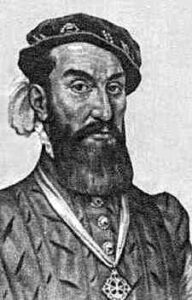
Cabeza de Vaca.
Cabeza de Vaca. In 1528, Panfilo de Narvaez, a Spaniard, led an exploring expedition westward from Florida along the Gulf of Mexico. Through various misfortunes and hardships, nearly all of the party perished. One of the commanders, Cabeza de Vaca, and three of his men were taken prisoners by the Indians. After being held in captivity for nearly six years, they succeeded in making their escape. After an adventurous journey of nearly two years, they fled westward and reached a Spanish settlement near the western coast of New Spain. The exact route followed by Cabeza de Vaca and his companions can never be known. However, his accounts of their wanderings were primarily the cause of the expedition of Francisco Vásquez de Coronado, who was the first white man known with certainty to have traveled across what is now Kansas.
Purpose of the Spaniards. The chief purpose of all the Spanish explorers was to search for wealth. Cortez said this to the Indians: “We Spaniards are troubled with a disease of the heart for which we find gold, and gold only, a specific remedy.” The hope of finding gold and precious stones lying about like pebbles lured many Spaniards into enterprises filled with terrible hardships. Reports of fantastic cities of untold wealth to the northward, the “Seven Cities of Cibola,” as they were called, had reached New Spain at various times. When Cabeza de Vaca told similar tales that he had heard from the Indians, it stirred the Spaniards to explore the region.
Coronado. Great preparations were made for an expedition. An army of 300 Spaniards and 800 friendly Indians was gathered and placed under Coronado’s command. This was a large army for those times, and the burden of furnishing it with arms and supplies fell heavily on New Spain. But so hopeful were the people of the expedition’s success that no sacrifice seemed too great. In the spring of 1540, the long march into an unexplored country began.
The Search for Quivira. After months of travel in a northerly and then in a northeasterly direction, Coronado and his army reached the province of Cibola, which was probably in the western part of what is now New Mexico, and the “Seven Cities” proved to be ordinary adobe Indian villages. They took possession of the Indian supplies and spent the winter in the villages. The Indians, anxious to get rid of their unwelcome visitors, persuaded a Quivira Indian, whom they held as a prisoner, to tell the Spaniards’ tales of the wonderful land of Quivira to lead them off into the wilderness where they would die from lack of food and water. Coronado and his men listened to this Indian, whom they called “Turk,” and followed him as a guide for many days. He led them steadily toward the east, and after a time, they became convinced that they were being deceived and made him confess that Qui\’ira was far to the northward. They had been only too willing to listen to Turk’s stories, but when they learned that he had misled them, they put him to death. Supplies were now low, and Coronado sent back the main body of the army, composed of footmen and 30 horsemen, to start northward.
Coronado in Kansas. It must be remembered that the whole country was a vast wilderness without names or boundary lines, and we can describe the journey of the Spaniards only by using names and boundary lines that have existed long since that time. As nearly as can be learned, Coronado and his men entered Kansas about where Clark County now is and went northward, crossing the Arkansas River at or near the site of Dodge City. From this point, they followed the river to Great Bend, then continued in a northeasterly direction to the vicinity of Junction City. At the end of their journey, they set up a cross bearing the inscription: “Francisco Vasqueth de Coronado, commander of an expedition, arrived at this place.”
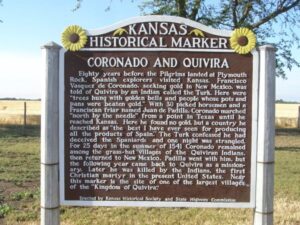
Kansas marker gives a brief history of Coronado’s travels to the area in 1541, located along US Hwy 56 west of Lyons, Kansas.
Quivira Found. After all this weary journey, they had reached Quivira and found it merely the home of a tribe of Indians, the Quivira, later known as the Pawnee. Cornado wrote in a letter to the Kind of Spain:
“The country itself is the best I have seen for producing all of the fruits of Spain, for, besides the land itself being very fat and black and being very well watered by creeks, springs, and rivers, I found prunes like those in Spain and nuts and delicious sweet grapes and mulberries. I remained 25 days in this province of Quivira to see and explore the country and to find out whether there was anything beyond which I could be of service to Your Majesty because the guides who had brought me had given me an account of other provinces beyond this. And what I am sure of is that there is not any gold or any other metal in that country. The other things that they told me are nothing but little villages, and in many of these, they do not plant anything and do not have any houses except skins and sticks, and they wander around with the cows. So that the account they gave me was false because they wanted to get me to go there with the whole force, believing that as the way was through such uninhabitable deserts and from lack of water, they would get us where our horses and we would die of thirst. And the guides confessed this and said they did it by the advice of the natives of these provinces.”
Coronado’s Return to New Spain. Empty-handed, Coronado and his little band of Spanish knights turned toward New Spain and carried to their waiting countrymen the disappointing story of their two-year expedition. With this event, 50 years had passed since the discovery of America, and little attention was paid to the Kansas country for the next two and a half centuries.
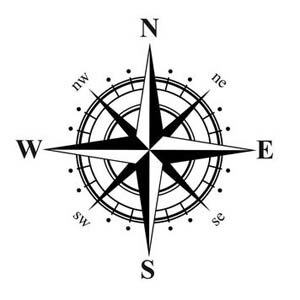 Summary. Kansas’s history begins with white men’s first exploration of this country nearly 400 years ago. Spain was the first nation to explore the New World. The chief purpose of the Spaniards was to find gold. They had heard from the Indians of prosperous cities to the northward, and when Cabeza de Vaca told them similar tales, the people of New Spain decided to explore the country. They sent Coronado with a large army on a two-year exploration journey. He failed to find gold, but his expedition was interesting because he was the first white man to traverse Kansas.
Summary. Kansas’s history begins with white men’s first exploration of this country nearly 400 years ago. Spain was the first nation to explore the New World. The chief purpose of the Spaniards was to find gold. They had heard from the Indians of prosperous cities to the northward, and when Cabeza de Vaca told them similar tales, the people of New Spain decided to explore the country. They sent Coronado with a large army on a two-year exploration journey. He failed to find gold, but his expedition was interesting because he was the first white man to traverse Kansas.
Compiled & edited by Kathy Alexander/Legends of America, updated May 2024. Source: Arnold, Anna E.; The State of Kansas; Imri Zumwalt, state printer, Topeka, Kansas, 1919.
Also See:

